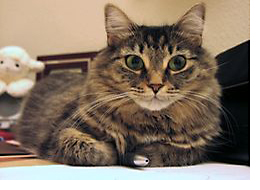 Although the tabby cat may not be an unusual sight, it is indeed as special as the individual animal sporting the colors itself! The word has fascinating roots. It derives from the French, tabis, which in turn comes from the Latin attabi. Both words refer to the original meaning, which is even further away, hailing from the Attabiyah section of Baghdad where it refers to a type of striped silk. This was later used (no one knows exactly when) to describe the marking on a cat’s coat.
Although the tabby cat may not be an unusual sight, it is indeed as special as the individual animal sporting the colors itself! The word has fascinating roots. It derives from the French, tabis, which in turn comes from the Latin attabi. Both words refer to the original meaning, which is even further away, hailing from the Attabiyah section of Baghdad where it refers to a type of striped silk. This was later used (no one knows exactly when) to describe the marking on a cat’s coat.
Whatever the origins of the word, the tabby cat is often mistaken for a breed, and its coloration is found both in the mongrel population and in many known cat breeds. It refers exclusively to the stripes, dots and swirling patterns that are so prevalent on the coats of cats bearing this name. In fact, it is most interesting to note that this tabby pattern is believed to be the original basic pattern on the coats of cats that roamed the ancient world. When cats are allowed to breed randomly, the result is an almost standardized coloration of brown mackerel tabby with green eyes.
There are three classic and distinct tabby types and a fourth spotted version, which is still under genetic investigation. The most recognizable is the brown tabby in the United States and the black tabby in the United Kingdom. Technically speaking, it is a black cat with an agouti (irregularly striped pattern) gene that causes the fur to break into designs of black and brown. Any cat color, including tortoiseshell, can appear in a tabby pattern and tortoiseshell tabbies are usually called “torties.”
The first type, which is the most common, produces the mackerel striped tabby (stripes look like fish bones and may break up into bars or spots). A second type is known as Abyssinian ticked or non-patterned agouti tabby, which results in a salt and pepper type of patterning. The third category is the classic pattern, which is distinguished by a blotched type of design on the head of the cat, but the body markings are usually whorled and swirled with thicker stripes that create what are known as “butterfly” patterns on the shoulders.
Do YOU own a tabby cat? Please share.
Related Articles:
“The Calico Cat: A Patch of Joy”
http://blogs.families.com/admin/b2browse.php?blog=28&p=10673

